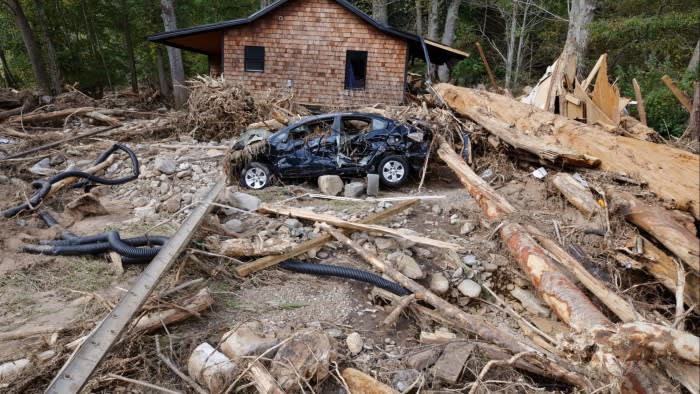Unlock the Editor’s Digest for free
Roula Khalaf, Editor of the FT, selects her favourite stories in this weekly newsletter.
The death toll in the US from Hurricane Helene has risen to more than 200, with many more unaccounted for, as communities across six states reel from its effects including more than half a million homes left without power and short of clean water.
The federal government has deployed soldiers and military helicopters to help emergency workers reach people stranded in remote towns unaccustomed to such brutal weather. Flooding has destroyed highways and torrential rain has unleashed mudslides on people’s homes.
The toll was highest in North Carolina, where almost 100 fatalities were estimated, followed by South Carolina. The southern states of Georgia, Florida, Tennessee and Virginia were also badly affected.
Vice-president Kamala Harris will travel to North Carolina on Saturday. The Democratic presidential nominee has already been to Georgia, where she helped to distribute meals and spoke with families in Augusta.
President Joe Biden, too, has travelled to areas hard-hit by the storm, and said he may ask Congress to return from a planned recess to pass a bill that would send more federal funds to affected areas.
The crisis come just weeks before November’s US presidential election, at a time when millions of voters are already casting early ballots, either in-person or by mail. Election experts have warned that the destruction in North Carolina, a critical swing state, could lead to a significant disruption to voting there.
While much of North Carolina is still focused on locating missing people, securing drinking water and clearing debris from crushed homes and cars, analysts warned that disruption could have broader economic implications.
Estimates of the damage varied wildly, as authorities in the worst hit areas were too swamped by rescue and recovery efforts to assemble reliable information.
Moody’s Analytics put the economic cost at up to $34bn, with property damage a significant component at up to $26bn and the remainder due to business disruption.
It did not put a figure on insured losses, but a report from Panmure Liberum put estimates at up to $9bn. Insured losses would have to be more than $10bn for a “spillover” into the reinsurance market, it said.
At the upper end of the range, AccuWeather, a weather forecasting service, estimated that losses from the damage to highways, bridges and railway tracks and from business disruption could amount to $250bn.

President Biden ordered 1,000 soldiers to go to devastated regions earlier this week, to assist with delivery of food, water and other aid.
The troops joined 6,000 National Guard members and more than 4,800 federal workers spread across the affected states, including 1,200 emergency workers in North Carolina.

The defence department also said this week that it had activated 22 helicopters and dozens of high-water vehicles to aid rescue efforts, while the Army Corps of Engineers was supporting debris removal, wastewater management and bridge inspections.
More than half a million people across Georgia, South Carolina and North Carolina were still without power on Friday afternoon, according to the tracking site PowerOutage.us. The White House said this compared with a peak of 4.6mn people without power last Friday at the height of the storm.

The Federal Emergency Management Agency said it had provided 50 Starlink satellite systems to bolster communications services after internet and mobile networks failed across the affected regions.
Grassroots groups in western North Carolina were organising through social media to disperse food, water and petrol to rural communities that became isolated after mudslides and raging rivers destroyed roads.

Helene is the eighth Atlantic hurricane of category four or five strength to make landfall in the US in the past eight years.
It so far ranks as the most deadly named storm to hit the mainland US since Katrina in 2005, though that hurricane claimed a much higher toll estimated at 1,400 in a 2023 report by the National Oceanic and Atmospheric Administration.

Scientists have found that warming sea temperatures are linked to more intense hurricanes. A preliminary study from the Lawrence Berkeley National Laboratory in California found that climate change may have boosted the amount of rainfall over parts of Georgia and North Carolina by as much as 50 per cent.
Climate Capital

Where climate change meets business, markets and politics. Explore the FT’s coverage here.
Are you curious about the FT’s environmental sustainability commitments? Find out more about our science-based targets here
